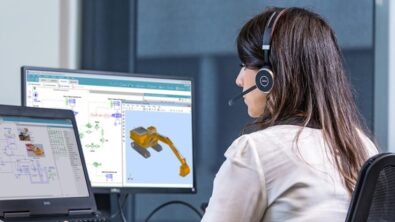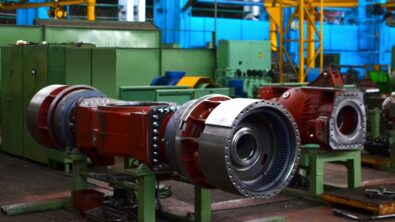Differentiate yourself as a supplier to heavy equipment OEMs with accelerated equipment part design

As a heavy equipment part supplier, you must accelerate your equipment part design process and acquire new skills to keep up with increasingly complex and unique requests. But also, global trends are forcing OEMs to revisit their sourcing strategy to improve supply chain resilience and sustainability, and to reinforce them in their innovation ambitions. Discover how Siemens can help heavy equipment part suppliers differentiate themselves in these areas.
Siemens helps you…
- Find all you need in one cloud-based SaaS solution
- Achieve maximal output for minimal IT investment
- Become ready to face today’s design challenges
- Improve your overall business performance
You will achieve this with…
- Multi-disciplinary design
- Improved design process efficiency
- CAE capabilities to frontload design decisions
This will let you differentiate yourself from the competition…
Keep up with tight timelines on increasingly challenging equipment part design projects
Whether you make classic components like alternators, differentials, or hydraulic cylinders, more advanced parts like electronics or navigation systems, or develop software, you know the time sensitivity of your business. When the harvest season comes, or when preparing for a construction project or a mining opportunity, OEMs want equipment part suppliers who can respond fast and keep deadlines. Both for new equipment and in a service or maintenance context, equipment availability is critical for OEMs1, as any delay could have financial consequences for their customers, causing reputation damage, chargebacks or even lawsuits.
Master complex and unique equipment part design requests
You cannot afford to be the weakest link in the supply chain – the one who is slowing down customers – even if they come with challenging and unique requests. With electrification and innovative digital capabilities rapidly gaining ground in the industry, your parts must be integrated in increasingly complex pieces of heavy equipment, interacting with many other systems such as mechanical, electrical, electronics, or software. And as today’s OEMs are differentiating themselves based on their ability to address region-specific market requirements and/or individual customer preferences, they often need you to supply them with tailor-made parts, while keeping the usual tight timelines.
Cut down lead times while remaining flexible to meet moving targets
To keep up with these evolutions, you must accelerate your equipment part design process. Avoid iterations, whether with customers or within your organization. Cut outsourcing of tasks for which you may not have skills in-house – typically those that require advanced capabilities like simulation and testing. Outsourcing is expensive and reduces your flexibility when OEMs change their requirements along the way. Building your own know-how, adopting processes in which you can drive complex equipment part design, and setting up a framework for real-time communication and collaboration between all design stakeholders will be critical to continue responding to each equipment part design request with efficiency.
Differentiate yourself with sustainable products and future-proof vision
Time, cost, and flexibility have probably for decades been your key priorities (along with product quality), as procurement decisions by OEMs were primarily driven by labor and transportation costs, lead time, working capital, taxes and duties, defect rates, and more. While continuously globalizing their activities, OEMs were scanning the equipment part supplier market to maximize efficiency and convenience with a just-in-time mindset. Today, some global trends have added new priorities, changing the established order in the equipment part supplier business landscape.2,3 More than ever before, it has become vital to differentiate yourself from the competition in those areas.
A time of new opportunities and risks for equipment part suppliers
Due to recent supply chain disruptions and geopolitical turbulences, many OEMs started revisiting their sourcing strategies. Besides cost, they are prioritizing supply chain resilience and flexibility, shifting from a just-in-time to a just-in-case thinking. Reducing procurement risk to protect business continuity happens, for example, by building redundancy into the supplier network, or via reverse shoring. The resulting redistribution of global supply activity presents both risks and opportunities for equipment part suppliers like yourself.4,5 Increasingly, you must prove you are a reliable partner who can deliver on a global basis. Having tools to communicate transparently with OEMs is key.
Prioritize sustainability in equipment part design
In parallel, sustainability has become critical. As public companies, most OEMs must report on their environmental, social, and governance (ESG) performance. This greatly impacts their equipment part supplier choice. PwC estimated that up to 90% of a company’s sustainability risks originate from its supply chain.6 Also, as more governments start introducing measures like ESG-driven border taxes, lack of sustainability measures can become costly. As sustainability is no longer optional, as an equipment part supplier, you must address it – even see it as a potential differentiator – and report on it to your customers. This requires tracking all your activities and decisions during equipment part design.
Sustainability regulations not only amplify compliance risks but also drive higher purchasing costs. An example is the carbon border tax currently under review by the European Commission.
Boston Consulting Group
Become a frontrunner in innovation7,8
Finally, electrification and digital technologies are causing a shockwave throughout an industry in which, for decades, innovation has been evolutionary, not revolutionary. Established OEMs are struggling to future-proof their offerings. Suddenly, they can no longer rely on decades of expertise, but must heavily invest in disciplines that are outside their comfort zone. Realizing they won’t succeed on their own, many seek salvation in an ecosystem approach, partnering with tech companies, sometimes even forming joint ventures with competitors. Equipment part suppliers who are better at navigating this technology shift and accompanying change in business dynamics, have a competitive advantage.

Provide unique value and prove it
As you can see, being a successful equipment part supplier today requires more than keeping timelines and delivering cost-effective products. You must also be a reliable partner who makes sustainable products, and who can thrive in an innovation ecosystem. To be a supplier of choice, you must excel in all of those areas and prove it. Also, as OEMs are increasingly turning to digital tools like data analytics and artificial intelligence to navigate this complex tangle of sourcing priorities,9 it is getting harder for you to get noticed if you don’t come with hard evidence to demonstrate your unique value.
This is what your industry peers say
Together with Lifecycle Insights, Siemens conducted a survey amongst 300 respondents in various roles at suppliers to heavy equipment OEMs. Over half of them were C-level Executive or VP-level, spread across the United States, Brazil, Germany, India, and China. Asking what’s driving them to implement new technologies, 64% mention, obviously, ‘lower production cost’. But also, 59% mention ‘differentiate products based on performance’. So, when it comes to equipment part design, most equipment part suppliers realize they must step up their game, understand the priorities of their customers and turn those into their own.
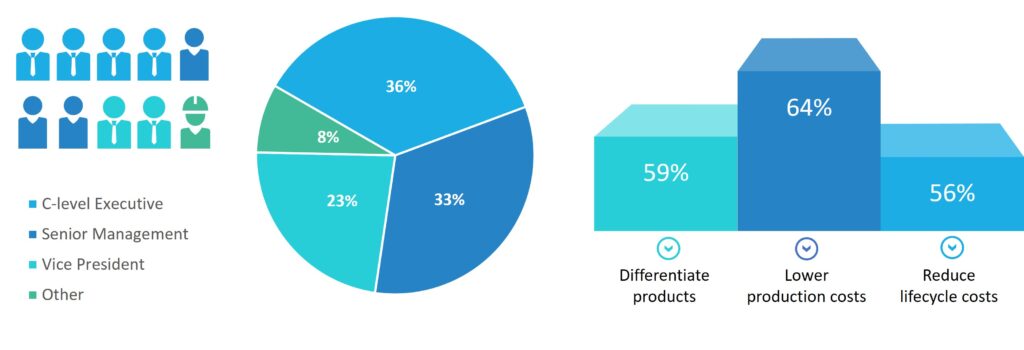
Improve your knowledge and design skills
Next, the survey asked respondents to rate on a scale of 1 to 5 how important they think certain aspects are for equipment part design. A vast majority of respondents gave ‘multidisciplinary design’, ‘design process efficiency’, and ‘CAE simulation’ a score of 4 or 5. However, when we asked about the challenges they face implementing such technologies in their daily operations, 67% said ‘justifying technology – it’s difficult to build a return on investment case’, and 66% said they are missing the knowledge or skills. It seems many equipment part suppliers know what they need for successful equipment part design, but they don’t know where and how to start.
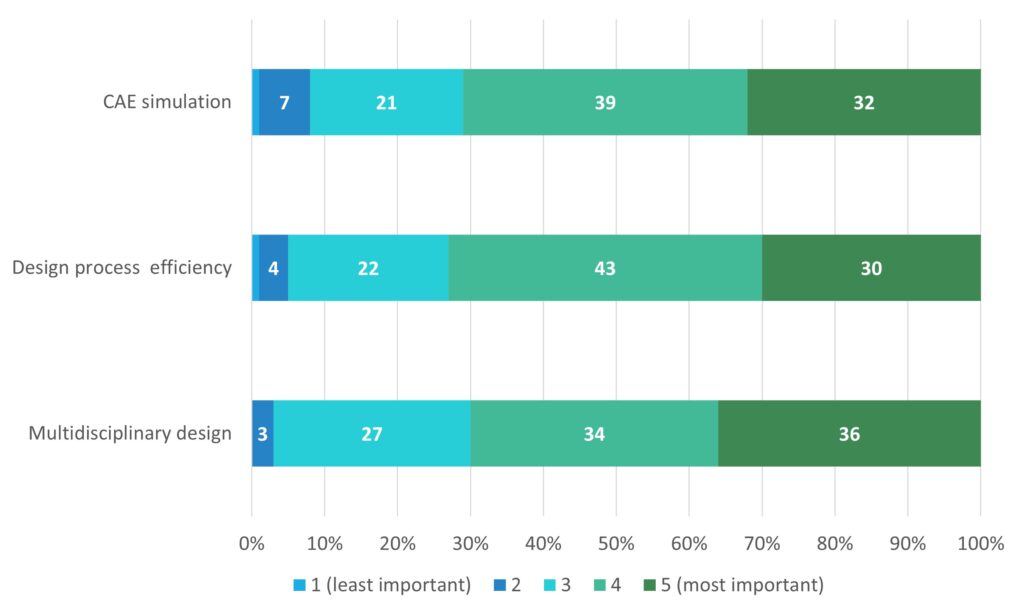
Deploy a solution that helps you be faster and more innovative
Find all you need in one equipment part design environment
Looking for solutions to lower the barrier to entry? Siemens Xcelerator™ offers heavy equipment part suppliers a comprehensive and integrated portfolio of software and services for equipment part design, accessible as a cloud-based SaaS solution. Siemens Xcelerator™ tools are:
- Open: Easy to combine with existing tools
- Flexible: Can be deployed at scale, on premises or via the cloud
- Easy to learn
By offering all you need for equipment part design and engineering in one environment, Siemens brings a wide range of technologies to any occasional user. Your engineers will have access to what they need and when they need it, thereby dramatically reducing outsourcing.
Maximal output for minimal IT requirements
As an equipment part supplier, you might not have the same budget and resources as OEMs to deploy and maintain a large portfolio of design and engineering software that requires a powerful infrastructure and must be kept up to date. With Siemens Xcelerator™, you can minimize the deployment effort for your IT department. Having these solutions accessible through the cloud as a SaaS solution dramatically reduces infrastructural needs, while you can continuously benefit from the latest and greatest technologies. In this way, you will be able to achieve maximum output with a minimal investment of resources.
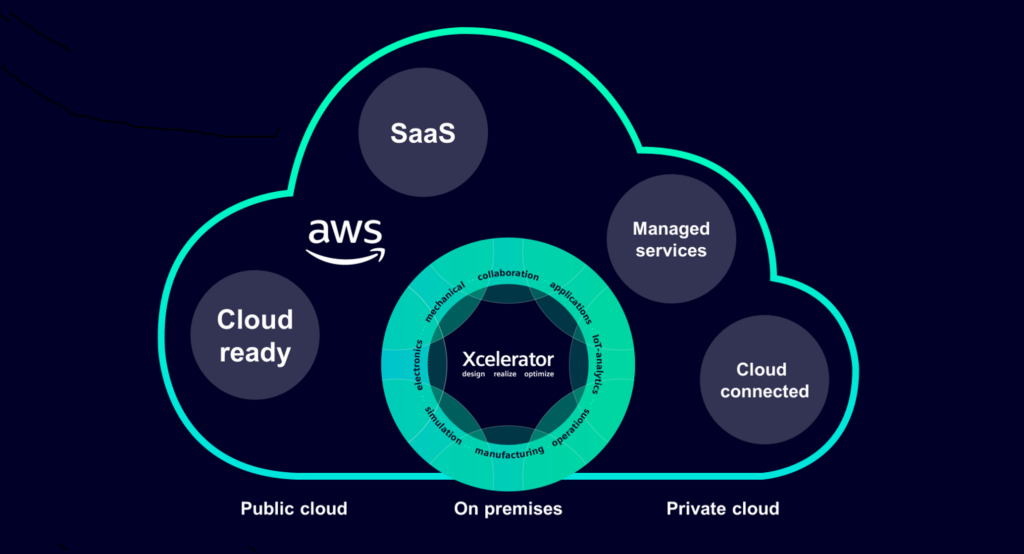
Face today’s equipment part design challenges
Siemens Xcelerator™ was built by leveraging decades of experience helping heavy equipment OEMs and their equipment part suppliers globally increase design confidence and improve efficiency. This helped Siemens understand the trends that are shaping the industry and the challenges those represent. Siemens takes into account that your business is time sensitive, your customers come with increasingly complex and custom requests and your people must continuously wear many hats, being involved in multiple projects simultaneously. Demonstrating your unique value to every customer is vital for your business.
Achieve better overall business performance with more effective equipment part design
As a part of Siemens Xcelerator™, solutions for Accelerated Equipment Design address exactly those areas your fellow equipment part suppliers indicated as critical for equipment part design: multidisciplinary design, design process efficiency, and CAE simulation. On top of that, Siemens solutions improve your capabilities for communication and collaboration, both between internal teams and with your customers and partners. By extending your in-house skills and offering tools that focus on improved efficiency and design automation, Siemens Accelerated Equipment Design solutions will help you increase return on investment through faster and better order processing, shorter lead times, reduced time-to-revenue, and better overall business performance.
Save massive time and cost during product development
Drive multi-disciplinary equipment part design
With Siemens tools, you can drive mechanical design, electrical & electronics systems design, and software development simultaneously from concept to validation without continuously having to switch between systems. Having a unified data model for all equipment part design activities eliminates iterations, as parameter changes are automatically propagated across disciplines and across equipment part design stages. A common user experience shortens the learning curve, making it easier for your engineers to switch between subjects and adopt new applications. These capabilities will boost equipment part design efficiency and are a prerequisite to master the multi-disciplinary nature of today’s complex equipment parts.
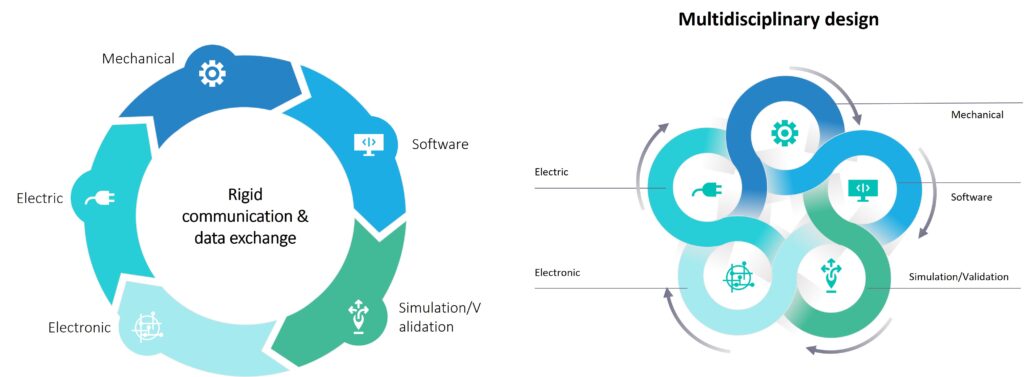
Boost equipment part design process efficiency
To further accelerate the path from requirements or specifications to parts or bids, Accelerated Equipment Design includes, on top of its powerful point solutions, tools that let you capture and leverage best practices. These include built-in workflows with embedded industry expertise and capabilities for defining custom equipment part design processes via templates. Aside from cutting down lead times, such tools will also help you drive standardization and set up design process automation, for example in the context of design exploration. All of this is offered in an environment that promotes focusing on reusing components across business lines, which is necessary to efficiently address any required degree of customization.
Frontload equipment part design decisions using CAE simulation
Siemens tools bridge the gap between equipment part design and engineering by combining CAD and CAE simulation on the same platform, offering associative connectivity between both areas. You can set up the entire product development process as a single continuous workflow where all models are linked, and decisions are tracked. Such a vertical integration brings expert solutions during early stages within reach of analysts, who can already outline certain variables that are usually only being fine-tuned during detailed engineering. Performing better analysis earlier presents significant opportunities to frontload equipment part design decisions, saving time and cost.
Differentiate yourself by delivering engineering excellence
Become a superior heavy equipment part supplier
Every minute your engineering experts save on mainstream equipment part design projects is time they can invest in R&D, to develop exactly those products that will differentiate you from the competition. Through Siemens Accelerated Equipment Design solutions, you will get on-demand access to any tool needed to develop the innovative, more sustainable solutions today’s OEMs are looking for. These tools will help you successfully switch to a future-proof offering without having to rely on outsourcing for advanced engineering activities. This will help you become a reputed brand in the equipment part supplier market that cannot be overlooked in an OEM’s sourcing process.
For suppliers, the adoption of battery-electric equipment means shifts in landscape and value chain. Suppliers have the opportunity to transform and reinvent to capture these opportunities. Preparing for this transformation will require suppliers to build the right assets and skills by investing in talent and upskilling.
McKinsey & Company
Transcend your supplier status
With Accelerated Equipment Design solutions, you can transcend your supplier status and become an essential player in your customers’ ecosystems. Siemens open tools welcome models and data from any source, allowing seamless communication with any external party. Sharing information is easy and secure, with full protection of your intellectual property. You work in an integrated product lifecycle management environment, where all data is stored and kept up-to-date, and where you have end-to-end traceability. This eliminates miscommunication and misalignment between project stakeholders and presents opportunities to provide proof points of all the great work you are doing, even in real time.
Summary: Leverage Accelerated Equipment Design to set yourself apart from your competitors
As a heavy equipment part supplier, time pressure is inherent to your business. Requests are becoming increasingly complex and unique, yet timelines remain the same. Even juggling between projects to respond fast, keep deadlines, and deliver cost-effective products is no longer sufficient. Trends like supply chain resilience, sustainability, electrification, and digitalization are influencing your customers’ sourcing strategy. In the Lifecycle Insights survey, your industry peers recognized the need for differentiation. With Siemens Xcelerator™, you can accelerate your equipment part design process and work on innovative and sustainable solutions that set you apart from your competitors.
Want to know more about heavy equipment part design?

Blog: Accelerated Equipment Design for OEMs – 3 must-haves for fast heavy equipment design
References
- Worldwide Machinery – A Guide to Choosing the Best Heavy Equipment Suppliers
- Deloitte – Time to consider supply chain reshoring?
- Deloitte – The road ahead: Four trends shaping the Industrial Products & Construction industry
- Boston Consulting Group – Revitalizing Global Sourcing to Balance Cost and Resilience
- McKinsey & Company – Risk, resilience, and rebalancing in global value chains
- PricewaterhouseCoopers – Your supplier’s ESG profile counts – why and how can you best manage it?
- Harvard Business Review – Heavy Machinery Meets AI
- McKinsey & Company – Harnessing momentum for electrification in heavy machinery and equipment
- McKinsey & Company – With artificial intelligence, find new suppliers in days, not months
